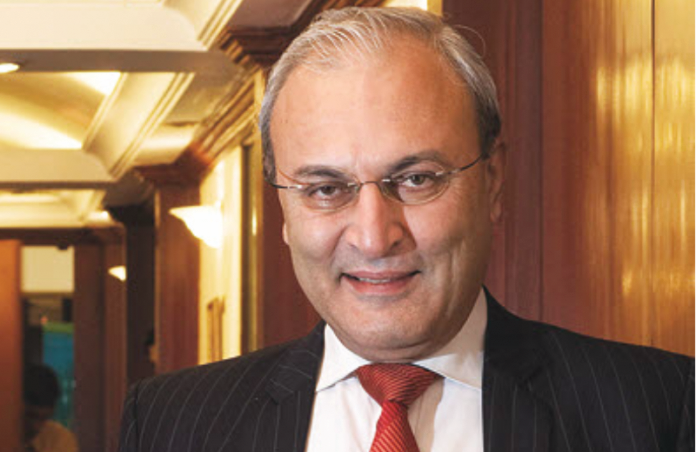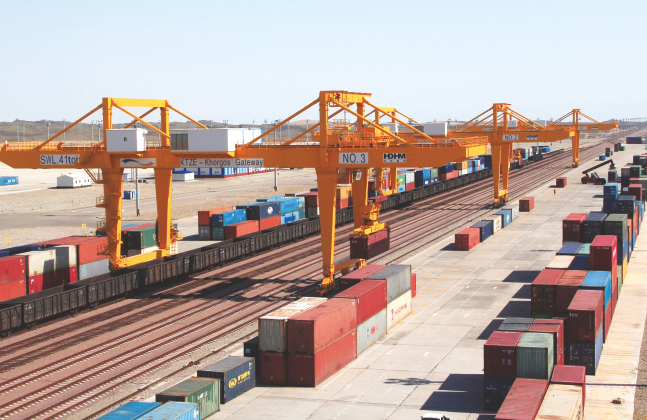DP World is looking to alter the way business is done in the world’s biggest landlocked country. Kazakhstan quite literally is at the crossroads of the New Silk Route connecting the East and West. A port, a logistics hub and a SEZ at Kazakhstan developed by DP World will make it the most significant trade corridors connecting Asia, Europe and Africa. It will be Advantage India too.
This is a story that has been in the works for almost six years now when the Kazakh Premier first approached the governments in the UAE to help strengthen the trade and logistics infrastructure of the country. Developing and strengthening road and rail networks would transform Kazakhstan in to an economic power house as it shortens movement of goods between the East and West by almost a month.
 “A voyage that would take 42 days or more by sea would probably take just 13 days by road and rail via Kazakhstan,” said Anil Singh, former CEO & MD (Sub Continent Region), DP World. When this was established as a fact both the Kazakh government that commissioned marine and inland development and DP World that was executing it swung in to action swiftly. Pacts were signed and cement, steel and equipment started moving to Aktau and Khorgos- the two border cities across the country marked for port and SEZ development.
“A voyage that would take 42 days or more by sea would probably take just 13 days by road and rail via Kazakhstan,” said Anil Singh, former CEO & MD (Sub Continent Region), DP World. When this was established as a fact both the Kazakh government that commissioned marine and inland development and DP World that was executing it swung in to action swiftly. Pacts were signed and cement, steel and equipment started moving to Aktau and Khorgos- the two border cities across the country marked for port and SEZ development.
For starters, Khorgos is on the China side of the Kazakh border and Aktau is located on the east bank of the Caspian Sea on the western side of the border. Estimates suggest that some $8 billion worth of cargo passes through this region every year. So the Silk Road, formerly known as One Belt One Road, is an ambitious plan to build a network of highways, railways and pipelines linking Asia via the Middle East to Europe and south through Africa. The economic land or “belt” takes cargo, in large part via Khorgos, through Eurasia. One the other hand, the maritime “road” links East and West via a series of ports to Africa and the Mediterranean.
Ergo, for goods to move across China westward and vice versa, Khorgos in Kazakhstan is being readied for a dry Port and a Special Economic Zone. Port of Aktau, where a new container terminal was set up is at an intersection of several international transport corridors. The port is on the Caspian Coast. For these two projects, agreements were signed between 2012 and 2017 for several value-added services to be provided alongside development of the region as a transport corridor.
“The logistics and industrial zone will also facilitate assembly of goods, packaging, labeling and other services to make the products shelf ready. Similarly, the Port of Aktau is being enhanced by implementing safety, commercial, engineering and operational procedures followed by DP World at other ports as well,” Anil Singh said. From 2011 onwards, DP World developed concepts looking at various innovative solutions offering turnkey advisory services. Handling cargo across two railway lines for instance. In the middle of a desert, DP World helped lift cargo for the Kazakhstan Temir Zholy with overhead gantry cranes across gauges. The port operator’s ambit of work also covers carrying cargo along the trans-continental routes where goods are moved by rail to Azerbaijan journeying on to the Black Sea towards Europe. The northern route opens in to Russia with the South-western route taking the cargo to Turkey and Iran.
DP World’s engagement in the Central Asian region also comes on the back of Kazakhstan seeing transportation as a way to diversify its economy away from almost total reliance on natural resource exports. The country is among the top three Uranium producing nations and has for long been dependent on oil and Uranium to balance other imports. Lately, Kazakhstan has been on a tear to improve its infrastructure and logistical capabilities. Between 2016 and 2017 Kazakhstan jumped from 51st to 35th place on the World Bank’s ease of doing business rankings, with big improvements in how straightforward it is to get construction permits or electricity.
These efforts to augment transportation would make sure more general cargo, grains, and steel move across the region. While the PCS implemented by DP World freed its trade zones from tedious documentation, long queues in administrative offices, delays and duplication, the road network hastened the movement of goods. The logistics zone and the transport hub came up in flat 16 months. The railway line was stretched and strengthened and the roadways were converted to 14- 16 lanes to ensure smooth flow of traffic. Speaking of his firm’s commitment to the region, Anil Singh reiterated that DP World will continue to advise the government of Kazakhstan to realise economies of scale in the supply chain, increase rail frequency and decrease the cost of transportation for shippers and end users.”
Bolstering trade and transportation in Kazakhstan will have collateral benefits to India too as better infrastructure will help carry goods from India to Europe through and the Kazakh region. Cargo moving by sea in to Central Asia and Europe has two routes. One, via the port of Bandar Abbas in Iran and then by road – rail to Moscow, St. Petersburg and beyond. A second prospective route would take goods from JNPT and Kandla Ports to the eastern side of the Caspian Sea, hitting up the new Kazakh-Turkmenistan- Iran railway in to CIS region. This international corridor could help India access these regions cutting cost and time by half, bolstering trade throughout a region that is rapidly integrating together and developing.
Regardless of geo-politics, these developments for now will be connecting nations, improving trade and cultural ties and taking smaller economies along the development path. Khorgos is the Suez Canal or the Panama Canal of Central Asia. DP World’s efforts are part of metamorphosing this obscure shipping hub in the heart of Eurasia to not only come alive but thrive. For long experts have said integrating the CIS in to the broad regional networks is key to improving world trade. The transportation corridor in Kazakhstan is a step in this direction.







